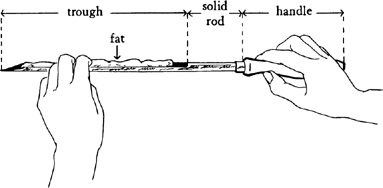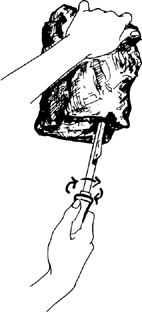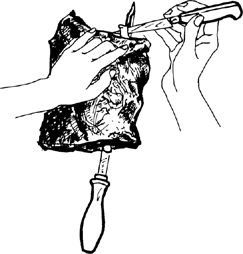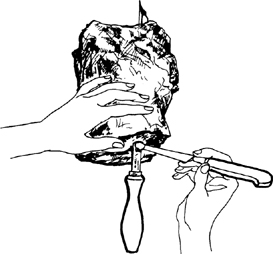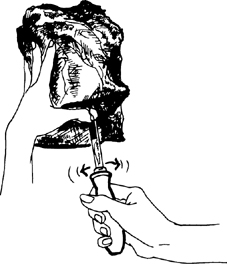Mastering the Art of French Cooking, Volume 2 (77 page)
Read Mastering the Art of French Cooking, Volume 2 Online
Authors: Julia Child

(*)
AHEAD-OF-TIME NOTE
: May be completed to this point as much as a day in advance; wrap in plastic and refrigerate.
4)
Braising the beef—3 to 4 hours
Because the beef has already been browned, you need only follow the general method outlined for the preceding
daube
with its brown roux,
here
, or the simpler braising method for the beef stew
here
with its
beurre-manié
sauce thickening.
5)
Serving
Unless the beef is carved and served at the table, there will be no
surprise
. After removing strings and other extraneous matter, place beef on a hot platter, spoon a little of the sauce over it, and decorate platter with vegetables or parsley. To serve,
pry cover loose and lift it, so that the garniture may be admired, then replace and cut straight through the meat as though it were a loaf of bread. Heap the garniture of mushrooms, olives, and beef cubes over each serving, and moisten with a big spoonful of sauce.
HOW TO LARD A PIECE OF MEAT
In the old days, when meat was tougher and far leaner than it is today, and when venison and game were plentiful, strips of pork fat were inserted through it to baste and moisten the interior of the meat during cooking. Now meat is larded more often because it is the stylish thing to do, and the bits of pork fat, ham, or whatever has been inserted make attractive designs when the meat is sliced.
Larding fat—pork fat and beef suet
The best fat to use is fresh pork fatback because it is hard and smooth. If you cannot find it, use blanched fat bacon or salt pork, or fat from the outside of a fresh pork loin. (If you do not wish to use pork fat, substitute suet from the outside of a rib or loin of beef.) Cut the fat into whatever length and width will fit your larding
needle, making a test piece first to be sure you will have a snug fit; chill the fat for easy handling.
The larding process
In order to lard meat you must have a larding needle, or
lardoire
, a hollow tube or trough of steel shaped like a giant steel pen point with a wooden handle.
Starting just back from the point, press the strip of fat down into the trough of the lardoire
, being sure fat fits snugly so that it will not slip out when the
lardoire
is pushed through the meat.
Meat is larded with strips of fat running parallel to the grain, so that when the meat is sliced you will cut across the strips of fat. Insert point of |
|
| With the point of a small knife, gently dig end of fat-strip out of trough at protruding end of lardoire |
Then dig other end of fat-strip out of trough at the other end of the lardoire |
|
| Hold the thumb of your left hand in the trough of the lardoire against the fat-strip, thus preventing fat from slipping out of meat while you slowly, with a slight rocking rotation left and right, withdraw the lardoire from the meat leaving the fat in its place |

